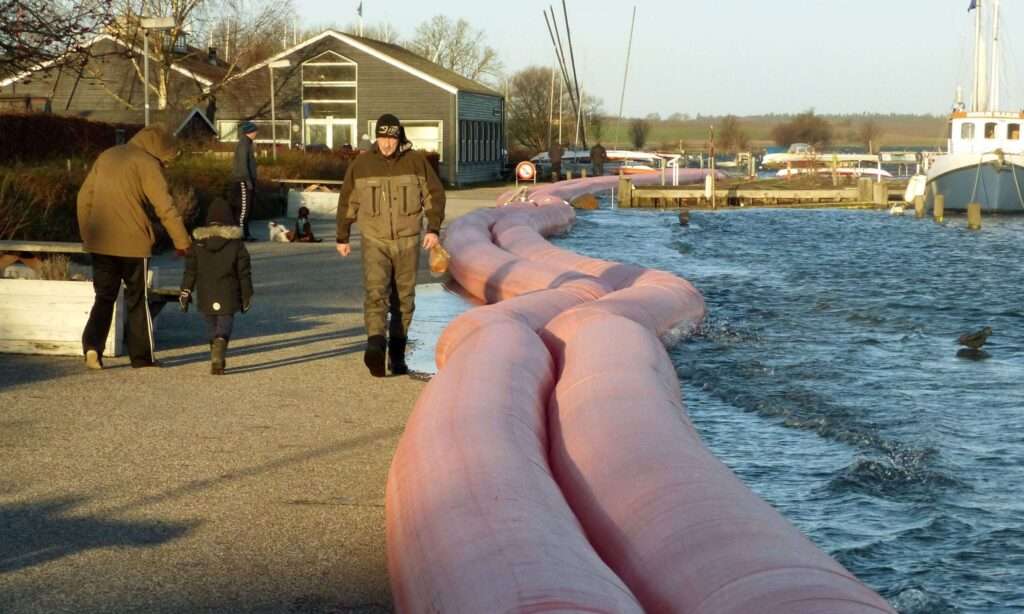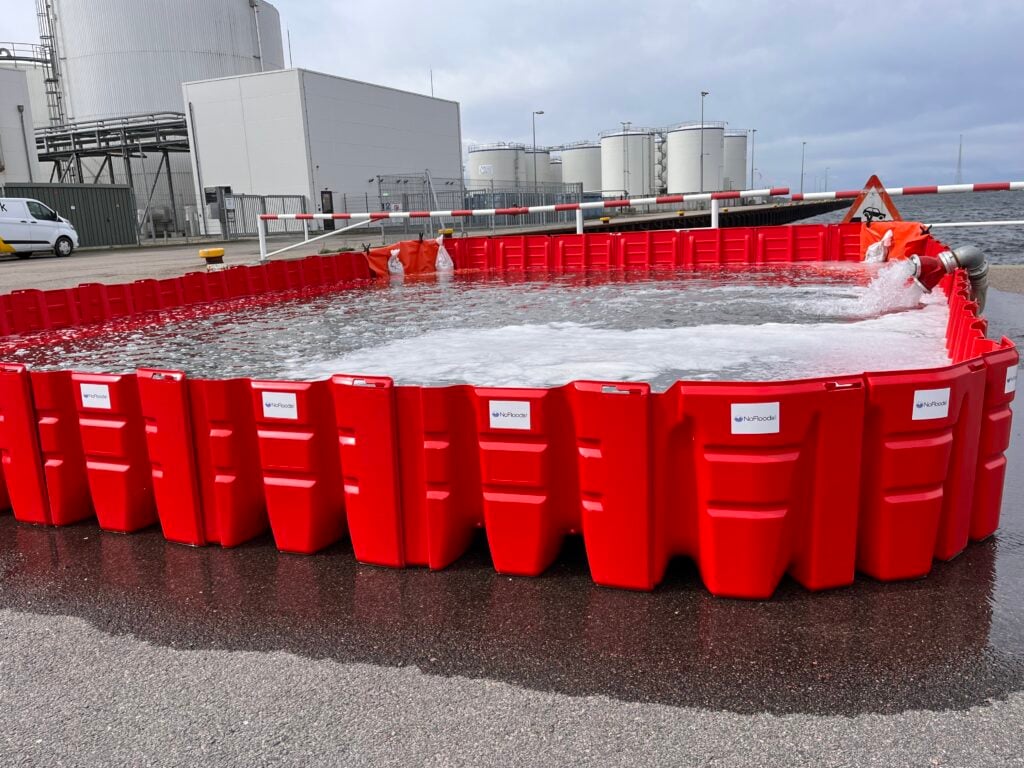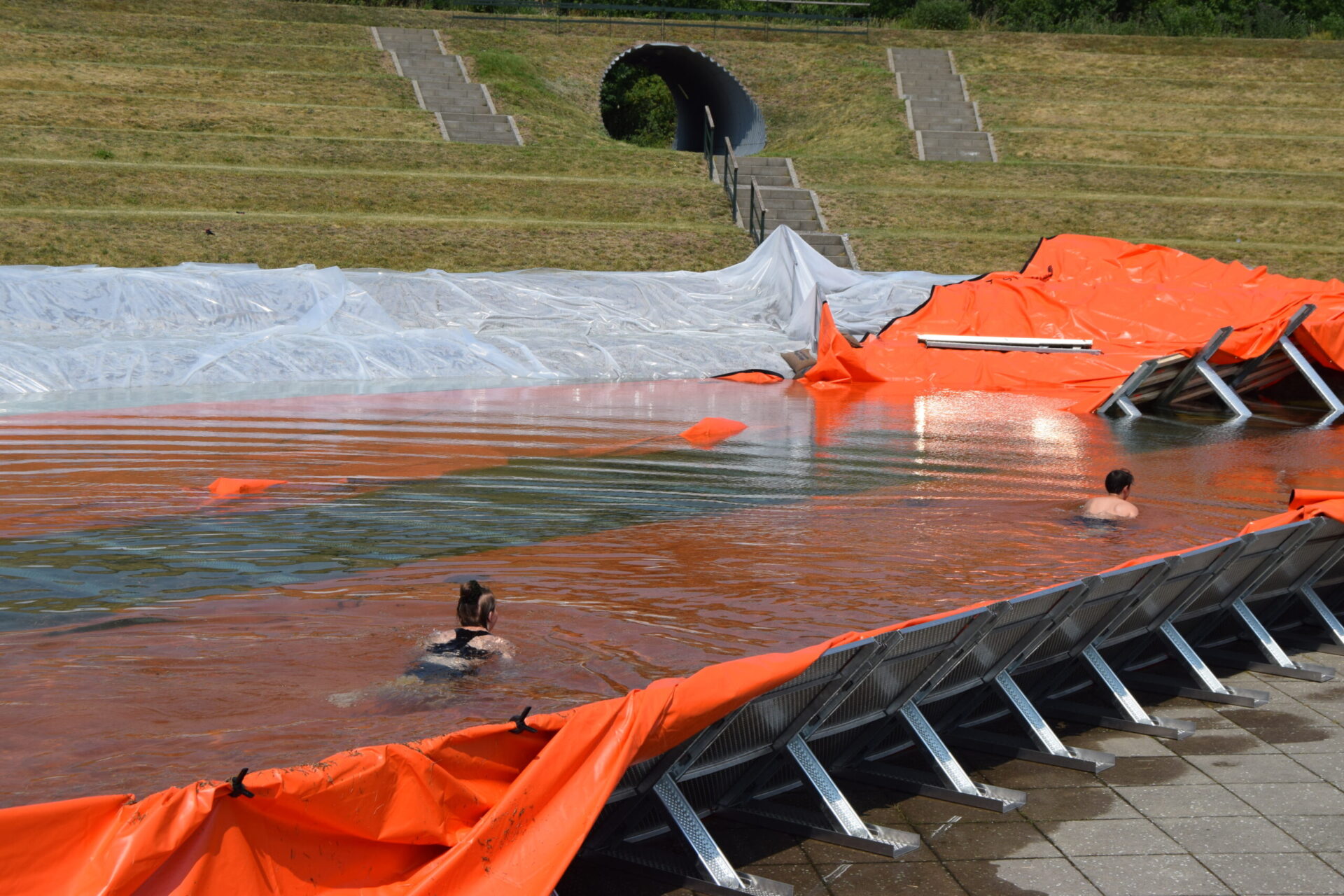Sustainable Sandbag Alternatives for Flooding
Traditionally, sandbags have been the go-to method for flood prevention but they come with many limitations.
They are bulky, heavy, labor-intensive to set up and some raise environmental concerns due to the disposal of their non-reusable materials.
Fortunately, there are several innovative and sustainable sandbag alternatives for flooding that not only offer effective protection but also minimize environmental harm.
Imagine fortifying your property against rising waters with lightweight and sustainable barriers that require minimal effort to deploy!
In this post, we’ll explore some of the best sustainable alternatives to sandbags that will help you protect your property while caring for the planet.
But let’s first look at how sandbags work and why they fall short in today’s environmentally-conscious world.
How Sandbags Work

Sandbags work by creating a physical barrier that blocks or redirects water flow during floods.
Here’s a simple breakdown of how they function:
1. Weight and Pressure – When sandbags are filled and stacked, their combined weight helps them stay in place even when floodwaters push against them.
2. Absorption – Sandbags don’t just block water, they also absorb it.
The sand inside can hold some water which helps to reduce the flow and amount of water seeping through.
3. Stacking for Height and Width – Sandbags are stacked in layers to create a taller and wider barrier.
The standard practice is to place them in staggered rows to interlock the bags ensuring stability while allowing the barrier to build up height and width to match the expected water level.
Disadvantages of Using Sandbags to Prevent Flooding
The video above clearly highlights several disadvantages of using sandbags as flood barriers. Here are a couple of them:
Time-Consuming and Labor-Intensive
Filling, transporting and stacking sandbags is a physically demanding process that requires significant time and manpower.
In emergency situations, this can be especially problematic as several people are often needed to complete the task quickly.
The labor-intensive nature of deploying sandbags makes them challenging to use, particularly in large-scale flooding events where speed and efficiency are critical.
Heavy and Bulky
Sandbags are difficult to transport and maneuver especially in large quantities or over long distances adding to the logistical challenges during floods.
Ineffective Against Heavy Flooding
Sandbags often fail to provide adequate protection during significant flood events.
They do not create a watertight seal and may be swept away by strong currents, leaving properties vulnerable.
Limited Durability
Sandbags can break down under heavy water pressure and prolonged exposure to floodwaters reducing their effectiveness over time.
Health Risks
After exposure to contaminated floodwaters, sandbags can harbor bacteria, mold and other harmful substances, posing health risks if not properly managed.
Messy Cleanup
Waterlogged sandbags can become a muddy mess, complicating the cleanup process and increasing the effort required after the flooding subsides.
Difficult Disposal
Once used, sandbags may be contaminated with floodwater and must be disposed of properly according to regulations.
This process can be cumbersome, costly and time-consuming.
Environmental Impact
Sandbags, especially those made from non-biodegradable materials like polypropylene, contribute to landfill waste and environmental pollution.
Improper disposal can also lead to soil contamination and habitat disruption.
Costly Over Time
While sandbags are relatively inexpensive initially, the cumulative costs of labor, transportation and disposal can add up, making them less cost-effective than modern sandbag alternatives in the long run.
Not Suitable for All Situations
Sandbags are less effective in situations involving groundwater flooding or areas that are already saturated.
They may not prevent water from seeping through, limiting their overall usefulness.
Aesthetic Concerns
Sandbags are often unsightly and can disrupt the visual appearance of properties or communities.
Factors to Consider When Choosing a Sandbag Alternative for Flooding
Effectiveness: The alternative should provide reliable protection against flooding.
This depends on the quality of the materials used and the design, ensuring it fits in the intended location to prevent water intrusion.
Ease of Use: A good sandbag alternative should be simple to deploy without requiring specialized skills or tools.
Durability: Consider how well the product will withstand exposure to water and environmental conditions.
Durable materials, such as ABS, PVC and other synthetic fabrics often provide better longevity compared to traditional sandbags.
Reusability: Look for options that can be reused multiple times without significant degradation in performance.
This not only provides cost savings but also reduces environmental impact.
Cost: Evaluate both the initial purchase price and long-term costs.
Some sandbag alternatives may have a higher upfront cost but could save money over time due to reusability and reduced labor needs.
Weight and Portability: Lightweight alternatives are easier to handle and transport, especially during emergency situations when quick action is necessary.
Storage Requirements: Consider how much space is needed to store the product when not in use.
Lightweight and compact options are more convenient for homeowners or businesses with limited storage space.
Availability: Ensure that the chosen sandbag alternative is readily available, especially during emergencies.
Accessibility can be crucial for timely flood response.
Application Specificity: Different alternatives may be better suited for specific flood scenarios e.g., urban flooding vs. rural areas.
Understanding the specific needs of your environment will help in selecting the most effective option.
Now that you know what to consider when choosing sandbag alternatives for flood prevention, let’s take a look at some of the tested and proven sustainable alternatives.
4 Trusted Sustainable Sandbag Alternatives for Flooding
1. NoFloods Barrier
The NoFloods Barrier is a highly effective and sustainable alternative to traditional sandbags, designed to provide reliable flood protection for various applications.
It comes in three models:

This model is ideal for professionals and large-scale applications, providing flexibility and efficiency.
It can be extended to cover lengths from 50 up to 1,000 meters or more, making it suitable for extensive flood control efforts.
The Pro model is designed with various terminals and junctions, allowing for customization based on specific site requirements.
Its robust construction allows for quick deployment and excellent performance against rising waters.

This model strikes an excellent balance between performance and cost, making it ideal for both professional and residential use.
Lightweight and easy to handle, it provides effective flood defense without the bulkiness of traditional sandbags.
Recommended for medium-scale deployments, this model ranges from 15 to 100 meters in length.
It also features water-filling capabilities in its terminals, ensuring a tight seal against floodwaters and allowing for dynamic adjustments in length as needed.

This entry-level model is designed for budget-conscious users seeking reliable flood protection without compromising on quality.
Offering the same sustainable benefits and ease of use as the other models, it makes effective flood defense accessible to everyone.
Ideal for shorter lengths between 5 and 25 meters, this model does not utilize junctions or terminals and provides a straightforward solution for basic flood defense needs e.g. for object protection & support.
Note
Each of the NoFloods models minimizes environmental impact while delivering effective protection, making them an excellent choice for anyone looking to replace traditional sandbags.
Notably, when installing 1 KM of the NoFloods models, CO2 emissions can be reduced by as much as 99.5% compared to using sandbags, highlighting their sustainability advantages.
Also, all the NoFloods barriers are reusable, easy to deploy and environmentally friendly, positioning them as a superior and clean alternative to sandbags.
2. NoFloods FlexWall

The NoFloods FlexWall is a versatile and flexible flood barrier that adapts to various landscapes and environments.
Its lightweight design makes it easy and extremely quick to deploy.
It uses incoming floodwater to help stabilize itself, providing a reliable and efficient way to protect against floods.
The FlexWall can be easily extended to fit specific flood defense needs, offering a cost-effective solution that is both sustainable and effective against rising waters.
The FlexWall takes up minimal storage space when not in use.
3. NoFloods Boxwall

The NoFloods Boxwall features a modular design that allows for easy setup and adjustment, making it suitable for various applications, from residential properties to commercial sites.
This freestanding temporary barrier provides quick response capabilities and can be rapidly deployed on hard surfaces like concrete and tarmac.
The Boxwall serves as an ideal alternative to sandbags.
Its stackable design facilitates easy transport and storage, making it an efficient option for emergency flood situations.
Additionally, the Boxwall can adapt to various configurations, ensuring comprehensive protection against rising waters.
4. NoFloods Alu Barrier

The NoFloods Alu Barrier offers a lightweight yet durable solution for flood protection.
Made from high-quality aluminum, it is designed to withstand harsh weather conditions while being easy to transport and set up.
Its robust and long-lasting design ensures strong protection against floods, making it a smart investment for enhancing flood defense strategies.
The Alu Barrier’s removable design allows for flexibility in deployment and combines durability with sustainability, providing an effective alternative to sandbags that contribute to landfill waste.
Frequently Asked Questions
What can you use instead of sandbags?
Sustainable Flood Barriers: Options like the NoFloods Barrier, NoFloods FlexWall, or other inflatable and modular barriers like NoFloods BoxWall can be effective.
Water-Filled Barriers: These barriers can be easily deployed and provide a strong flood defense by utilizing water for stability.
What is a reusable alternative to sandbags?
NoFloods Barriers: Models like the NoFloods Pro, Semi-Pro and Basic are designed for multiple uses and can be quickly deployed and removed.
Why can’t sandbags be reused?
Contamination: After exposure to floodwater, sandbags may be contaminated with pollutants or pathogens, making them unsafe for reuse.
Degradation: The materials used in sandbags can deteriorate over time, especially when exposed to moisture.
Do sandbags really stop water?
Sandbags can help slow down or redirect water flow but they do not create a completely watertight barrier.
In heavy flooding, they can be swept away or become ineffective if not properly installed.
What to use in lieu of sandbags?
Modular flood barriers such as the NoFloods barriers which can be rapidly deployed and reused.
What else can I use instead of sandbags?
Flood Shields: Products designed specifically for flood protection, like the NoFloods Barriers, provide robust defenses.
Do sandbags really help with flooding?
Sandbags can help to some extent by slowing water flow and protecting certain areas. However, they are not always reliable for severe flooding events and may require additional support.
What is the best defense for flooding?
Sustainable alternatives like the NoFloods Barrier offer a sustainable and reusable solution that can be quickly deployed in emergencies.
Conclusion on the Best Sandbag Alternatives for Flooding
With climate change driving more frequent and severe flooding, it’s time to rethink our reliance on using sandbags for flooding.
Sustainable sandbag alternatives for flooding, like the wide range of NoFloods Barriers provide effective and sustainable protection against rising waters.
Their lightweight design, ease of installation and reusability make them an ideal choice for individuals and communities seeking to strengthen their flood defenses.
Beyond protecting property, these innovative solutions minimize environmental impact, providing a smarter and greener way to manage flood risks.
They not only save time and labor but also offer superior durability compared to sandbags.
By choosing reusable materials, you help create a more sustainable future while ensuring your home or business is well-protected from floods.